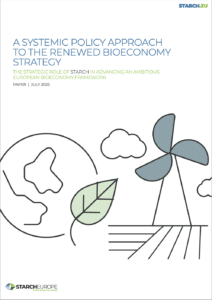A Systemic Policy Approach to the Renewed EU Bioeconomy Strategy
The starch industry stands at the crossroads of agriculture and industry, and we are uniquely positioned to support Europe’s net-zero transition, strategic autonomy, and industrial competitiveness. It is a key enabler of the bioeconomy, supporting both its foundational dimension—providing food, feed, paper products and personal care ingredients—and its transformational dimension—substituting fossil-based inputs across various industrial applications, including chemicals, materials, and energy.
Besides being one of the most fundamental ingredients in the human diet, starch is the first source of feedstock used in bio-based applications, both within the European Union and globally. Our industry is already contributing to the replacement of fossil-based ingredients in various sectors, including bio-based chemicals, bioplastics, cosmetics, textiles, and packaging. It is estimated (Carus et al. 2025) that, in 2023, 2,7 million tonnes of starch were used for paper production, 1 million tonnes allocated to pharmaceuticals, chemicals, and other non-food applications, and an additional 480.000 tonnes dedicated to bioethanol production.
Europe’s success in the bioeconomy depends on leveraging the proven capabilities and expertise of established bio-based industry actors, such as ours. In this context, the new Bioeconomy Strategy must acknowledge the role of the European bio-based ecosystem as a tangible and integrated agro-industrial reality, fully recognising its role in replacing fossil inputs while sustaining food security and other essential daily needs, and place it among the strategic pillars of the EU’s industrial and food sovereignty strategy.
Starch Europe therefore welcomes the European Commission’s initiative to revise the EU Bioeconomy Strategy. Below, you will find our perspectives on what the new EU Bioeconomy Strategy should be:


